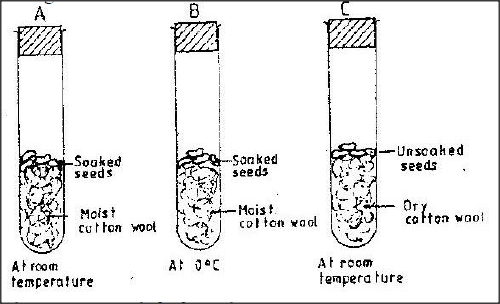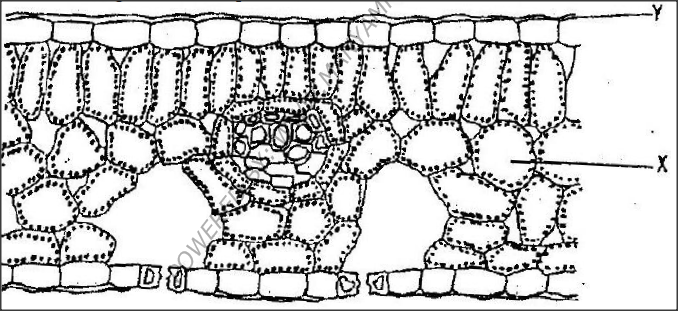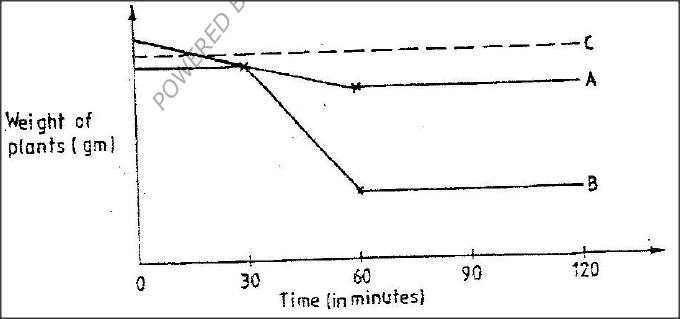K.C.S.E Biology Q & A - MODEL 2001PP1QN15
The diagram below represents a set up to investigate the conditions necessary for seed germination.
The set up was left for 7 days
(a) What conditions were being investigated in the experiment? (b) State three reasons for soaking seeds in set ups A and B (c) What were the expected results after seven days?
answers
(a) water, temperature moisture (Acc. Warmth)
(b) Mobilize/ hydrolyze stored food/ active enzymes/ breaking of dormancy softening the testa / seed coat ( acc. As a solvent/ transport media.) (c) Setup A – those in set up A will germinate Setup B- those in set up B will not germinate Setup C- those in set C will not germinate
0 Comments
K.C.S.E Biology Q & A - MODEL 2001PP1QN10
Name three sites where gaseous exchange takes place in terrestrial plants.
ANSWERS
K.C.S.E Biology Q & A - MODEL 2000PP1QN11
The diagram below represents a section of a leaf.
(a) Name the parts labeled X, and Y
(b) Using arrows indicate on the diagram the direction of flow of water during the transpiration stream (c) State two ways in which the leaf is suited to gaseous exchange
answers
(a) X– Spongy mesopyll ( cell) layer
(b) Y – Cuticle (c) Broad/ flat leaf ( lamina) to provide large surface area or absorption of gases Thickness: allow gases to pass though fast Presence of stomata for efficient diffusion of gases Presence of air spaces for easy defuses K.C.S.E Biology Q & A - MODEL 1999PP1QN16
Describe the:
a) Process of inhalation in mammals. b) Mechanisms of opening and closing of stomata in plants.
answers
a) Muscles of diaphragm contract; causing the diaphragm to flatten (from dome position. The external intercostals muscles contract internal intercostals muscles relax pulling the ribcage upward/forward and outward in man. These movements increases the volume of the thoracic cavity; reducing the pressure; of the thoracic cavity; compared to atmospheric pressure; this causes the atmospheric air to rush into the lungs. (Through the nostrils, trachea bronchioles and alveoli).
b) Theory- photosynthesis Guard cells have chloroplasts; in the presence of light; photosynthesis occurs in guard cells, producing sugar in guard cells; osmotic pressure increases/osmotic potential lowers; water from neighboring /adjacent cells enter into guard cells; causing turgidity of guard cells; causing turgidity of guard cells. Theory 1. Guard cells have chloplasts; in the presence of light photosynthesis occur in the guard cells of stomata; producing in the guard cells; osmotic pressure increases/lowers osmotic potential water from the neighboring /adjacent cells, enter into guard cells; causing turgidity of guard cells The inner walls of the guard cells are thicker than outer walls; so during turgidity the inner walls stretch more; causing the guard cells to bulge outward; stomata opens. Theory 2. Guard cells have chloroplasts (Day) in light; photosynthesis occurs in the leaf/guard cells lowering the CO2 concentrations; this increases PH/alkalinity which triggers of enzymatic conversion of starch to sugar (glucose); leading to low osmotic potential/ increased osmotic pressure in guard cells; guard cells absorb water from epidermal cells; thus becoming turgid; the inner walls are thicker than the outer walls; outer walls stench more than inner walls; causing guard cells to bulge outwards, stomata opens; In the absence of light (night); no photosynthesis; CO2 concentration increases due to respiration; PH lowered/ acidity increases; sugar converted to starch; osmotic pressure lowered/ osmotic potential increases; guard cells lose water to adjacent epidermal cell becoming flaccid; stomata close. Day low H+ high PH opens stomata. Starch glucose. Theory 3 Guard cells have chloroplasts; in light AT produced; the energy drives K+ irons from adjacent epidermal cells into guard cells; accumulation of K+ raises osmotic pressure (lower osmotic potential) of guard cells; guard cells absorbs water from adjacent epidermal cells; becoming turgid; the inner walls are thicker than the outer walls so outer walls stretch more than inner walls causing guard cells to bulge outward. Stomata opens. In the absence of light (night ) ATP rapidly decreases; no energy of potassium +ions pump ion; migrate by diffusion from guard cells to adjacent epidermal cells; become flaccid; the thinner outer walls of guard cells shrink
K.C.S.E Biology Q & A - MODEL 1998PP1QN04
Why are gills in fish highly vascularized?
ANSWERS
K.C.S.E Biology Q & A - MODEL 1997PP1QN13
An experiment was carried out to determine the rate of transpiration in three plants A, B and C. Plants, A and B belonged to different species while plants B and C belonged to the same species. Plant C had all its leaves removed. The three plants were of similar size and were exposed to the same environment conditions. The results are as shown below in the graphs below
(a) Suggest possible environment conditions under which the experiment was carried out between 30 and 60 minutes
(b) Account for the results obtained for plant C (c) Suggest the habitat for plant A and B. Give reasons for your answer. Habitat for plant A Habitat for plant B
ANSWERS
(a)strong air/ winds
High temperature Low humidity; accept dry conditions/ sunlight (b)Absence of leaves/ stomata absent Transpiration; / little transpiration (c)Arid/dry/ desert/ accept semi- desert Reason Low rate of water loss; accept more/ a lot of water loss Wet/Moist/aquatic Reason High rate of water/ high rate of transpiration /acc. A lot of water loss K.C.S.E Biology Q & A - MODEL 1997PP1QN06
Oil can be applied on the stagnant water to control the spread of malaria.
(a) How does this practice control the spread of malaria? (b) Give a reason why this practice should be discouraged
ANSWERS
(a) Mosquito larvae/ Pupae are killed; Accept suffocation/ Breaking life cycle of Mosquitoes
(b) Pollution of environment/ oil expensive, other aquatic are killed; accept Contamination.
K.C.S.E Biology Q & A - MODEL 1996PP1QN14b
Name two structures used for gaseous exchange in plants
answers
Describe the path taken by carbon dioxide released from the tissue of an insect to the atmosphere14/6/2020
K.C.S.E Biology Q & A - MODEL 1996PP1QN14
Describe the path taken by carbon dioxide released from the tissue of an insect to the atmosphere
answers
|
Archives
December 2024
Categories
All
TOPICSFORM 1
Form 2
Form 3
Form 4
|
Can't find what you are looking for? Don't worry, Use the Search Box Below.
|
Primary Resources
College Resources
Can't find what you want? Use this Search box. |
Secondary Resources
|
Contact Us
Manyam Franchise
P.O Box 1189 - 40200 Kisii Tel: 0728 450 424 Tel: 0738 619 279 E-mail - sales@manyamfranchise.com |











 RSS Feed
RSS Feed

